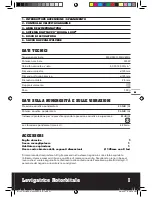
Random orbital sander ENG
OPERATING INSTRUCTIONS
1. ON/OFF SWITCH
To start your sander, depress the protective
cover over the switch at the position marked
”I”. To stop your sander, depress the protective
cover at the position marked “0” (See A).
2. VARIABLE SPEED CONTROL AND
FUNCTION
The unit is equipped with a variable speed
control. This allows you to adjust the speed in
order to achieve different finishes (See B).
3. HAND GRIP AREA
Your sander is designed to be held either
around the main housings (See D), or by the
top of the main housing (See C). When sanding
for long periods at a time, it is recommended
you periodically alternate between the two
holding positions.
4. CHANGING HOOK&LOOP SANDPAPER
The sandpaper and sanding disc are provided
with a hook and loop attachment system to
allow quick and easy changing of the sanding
and polishing accessories. Firstly, remove any
dust or other objects from the hook and loop
on the sanding disc and sandpaper. As the
sandpaper has dust extraction holes you must
align these with the holes in the sanding disc,
otherwise the dust extraction will not function.
To remove the sandpaper, lift one corner of the
paper and pull off from the sanding disc (See
E).
5. DUST BAG
Always operate your sander with the dust bag
fitted. For the best performance always empty
the dust bag in time. Open the zip and empty
the dust from the bag. To remove the bag (See
F). To refit the bag, firmly push the mounting
bracket into the location on the sander
housing (See G).
6. ORBITAL SANDING
Guide your sander parallel to the working
surface and move it in circles or in a cross
pattern. Do not tilt the tool in order to avoid
deep unwanted sanding marks. The amount of
material removed is determined by the speed
of the sanding disc and the grit size used. The
speed of the sanding disc diminishes relative
to the pressure applied to the tool. For faster
removal, do not increase pressure on the tool,
but use a coarser grit size.
7. SELECTING THE RIGHT GRADE OF
SANDPAPER
Different grades of sanding paper can be
purchased from good DIY shops. Available
grades are Coarse, Medium and Fine.
Use coarse grits to sand down rough finishes,
medium grit to smooth the work and fine grit
to finish off.
The higher the grade number, the finer the
grit. For rough work start with a low grade of
grit. (e.g. 60 grit) and change to a higher, finer
grade (e.g. 100 or 120 grit) for finishing. If you
use a fine grade for rough surfaces it will soon
clog and need changing.
It is best to make a trial run on a scrap piece
of material to determine the optimum grades
of sandpaper for a particular job.
8. PAD BRAKE
Your sander is equipped with a pad brake that
prevents over-speeding of the pad. If the tool
is lifted off the work surface while the motor
is running, the brake will limit pad rotation to
avoid unwanted sanding marks and gouges.
WORKING HINTS FOR YOUR
ORBITAL SANDER
If your power tool becomes too hot, especially
when used at low speed, set the speed to
maximum and run it with no load for 2-3
minutes to cool the motor. Avoid prolonged
usage at very low speeds. Always use sand
paper that is suitable for the material you want
to sand.
Always ensure the work-piece is firmly held or
clamped to prevent movement.
Any movement of the material may affect the
quality of the sanding finish.
Start your sander before sanding and turn it
off only after you stop sanding. For the best
results, sand wood in the direction of the
grain.
Do not start sanding without having the
sandpaper fitted.
Do not allow the sandpaper to wear away it
will damage the base-plate. The guarantee
does not cover base-plate wear and tear.
Use coarse grit paper to sand rough surfaces,
medium grit for smooth surfaces and
fine grit for the final surfaces. If necessary, first
make a test run on scrap material.
Use only good quality sandpaper.
The sandpaper controls the sanding efficiency,
not the amount of force you apply to the
09
08
M-13L-WU650-070305¸ÄFÓïCE´¦.indd 8
3/5/2007 4:08:11 PM
Summary of Contents for WU650
Page 2: ...M 13L WU650 070305 ÄFÓïCE indd 2 3 5 2007 4 08 07 PM ...
Page 3: ...M 13L WU650 070305 ÄFÓïCE indd 3 3 5 2007 4 08 07 PM ...
Page 4: ... M 13L WU650 070305 ÄFÓïCE indd 4 3 5 2007 4 08 07 PM ...
Page 5: ...A B C D E F G M 13L WU650 070305 ÄFÓïCE indd 5 3 5 2007 4 08 09 PM ...
Page 69: ...69 M 13L WU650 070305 ÄFÓïCE indd 69 3 5 2007 4 08 52 PM ...
Page 70: ...M 13L WU650 070305 ÄFÓïCE indd 70 3 5 2007 4 08 52 PM ...
Page 71: ...M 13L WU650 070305 ÄFÓïCE indd 71 3 5 2007 4 08 52 PM ...
Page 72: ...M 13L WU650 070305 ÄFÓïCE indd 72 3 5 2007 4 08 52 PM ...









































